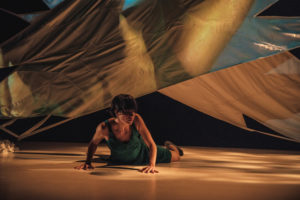Toronto: Spring 2018 - Vancouver Ballet Society
- Home
- City Reports 2015 - 2019
- Toronto: Spring 2018

by Michael Crabb
The problem with many garden-variety ballet galas is the monotony of star turns in bravura classical pas de deux. Although the second Canada All Star Ballet Gala convened at Toronto’s Sony Centre in October cleaved to the duet format, with offerings often extracted from longer works, the extraordinary variety of choreography, most of it new to local audiences, and the international mix of well-established and emerging talents, made for a satisfying evening.
The first Canada All Star Ballet Gala — such a clumsy name — was held in February 2017, the brainchild of former Bolshoi Ballet star and now National Ballet of Canada principal dancer Svetlana Lunkina. Although Lunkina is the gala’s producer/curator, the events are not built around a single star name.
The first gala highlighted the various schools of classical dance. This second edition was designed to reveal how much the art of ballet has evolved in the hands of such choreographers as Roland Petit, Mauro Bigonzetti, Yuri Possokhov, Wayne McGregor and David Dawson.
Seen as a totality, two things emerged. Where contemporary choreography is concerned, there is a preponderance of hyper-physicality and angular disharmony that tends toward sameness. Had William Forsythe been among the choreographers, we might have been able to pinpoint the genius behind this prevalent new aesthetic.
Related to this, one detects a more nuanced and complex reading of gender relationships. Where romance is evident, it is not idealized. Women are neither icons nor odalisques. The traditional power imbalance of strong male and delicate female is replaced with something approaching a meeting of equals — not a bad takeaway for a ballet gala.
Although it does not call itself a gala, Fall for Dance North (FFDN), the Toronto version of the New York City dance-smorgasbord original, could certainly qualify. It is celebratory, culturally inclusive and, in part because of the flat $15 price point, hugely popular, effectively selling out the 3,200-seat Sony Centre for three nights. There’s no accurate to way to measure its spillover effect, but some audience first-timers were doubtlessly seduced into becoming lifetime dance devotees.
Highlights of the October 2017 edition included the local debut of Canadian expatriate Eric Gauthier and his Stuttgart-based Gauthier Dance, in the FFDN-commissioned Children of Chaos by National Ballet choreographic associate Robert Binet, featuring a cast of Canadians who, like Gauthier, have built careers abroad. Another was Charles Moulton’s 1979 Precision Ball Passing, reconfigured for a community-drawn cast of 72. It may not be dance in the conventional sense — it was made in the last gasps of American postmodernism — but it is a physical spectacle of oddly haunting beauty and humanity.
In what even by Toronto standards was an exceptionally busy fall, ProArteDanza featured a substantial premiere by Matjash Mrozewski, Future Perfect Continuous — English grammar gurus will recognize the title’s derivation — that, with a mix of dance and spoken word, takes a wry look at climate change. It’s almost like a danced play — playwright Anna Chatterton wrote the text — and the cast of 12 executes their dual responsibilities impressively. Future Perfect Continuous succeeds in being neither didactic nor preachy and, by offering a jumble of conflicting viewpoints, ultimately reflects the overwhelming complexity of the climate change debate — as if there needs to be a debate — and the daunting prospect of grappling with something so huge.
ProArteDanza’s Anisa Tejpar, who performed in Mrozewski’s new work, presented her first solo show in November, an ambitious production that packed the Aki Studio Theatre. In Time is a collaborative endeavour with choreography by Hanna Kiel, original music by John Gzowski, lighting by Simon Rossiter, video design by Jacob Niedzwiecki, outdoor film footage by Jeremy Mimnagh and an effective set design by Joe Pagnan. Tejpar did all the dancing and her own costuming.
In Time is at one level a personal piece, reflective and introspective, but, in its subtle exploration of memory and the passage of time, it is sufficiently universal in theme to move beyond the purely biographical.
Kiel’s choreography gives Tejpar, always a powerful stage presence, ample opportunity to display her command of dynamics, of speed and stillness, force and delicacy. Projected imagery floats at times surreally on the stretched fabric butterfly wings of Pagnan’s design, like fragments of a jigsaw puzzle. Memory, it appears, is a retrospective construct that wriggles and morphs.
Memory is also a component of Dreamwalker Dance artistic director Andrea Nann’s new work Dual Light, but where In Time plays with memory as a means of grasping a fugitive reality, Dual Light embraces and even celebrates the transitory nature of human experience.
Dual Light, made by Nann in collaboration with fellow performers Kristy Kennedy, Yuichiro Inoue and Brendan Wyatt, proceeds by scenes, covering a lot of ground — personal and universally philosophical. The performers recount particular experiences. Their physical interactions seem as much spontaneous as choreographed. A linking thread is an exploration of how life unfolds in a flow of transitions, of departures and arrivals, literal and metaphorical.

Photo: Francesca Chudnoff
